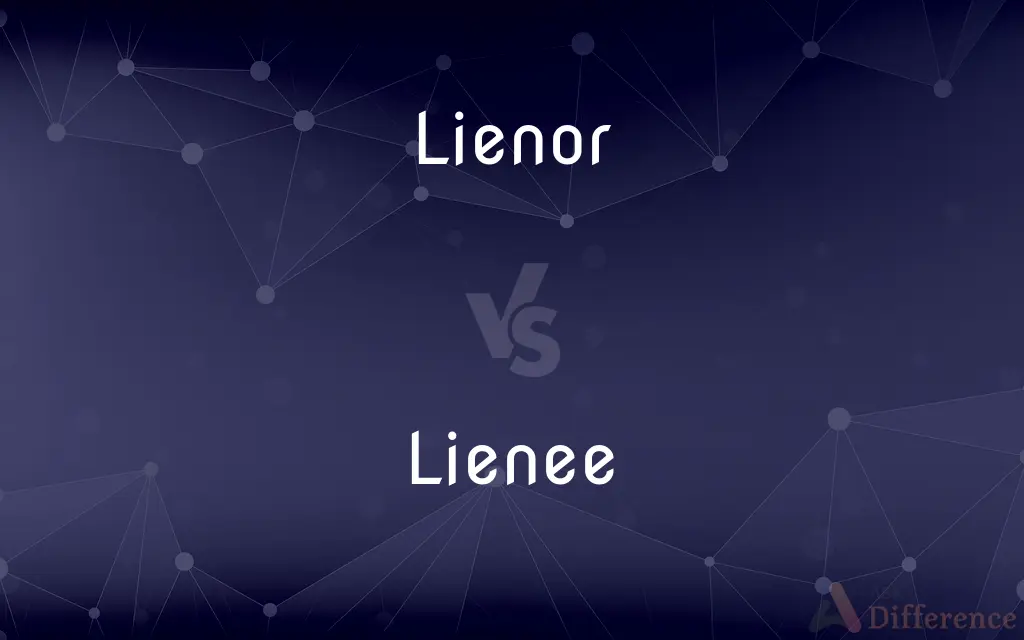Lienor vs. Lienee — What's the Difference?
By Fiza Rafique & Maham Liaqat — Updated on April 15, 2024
Lienor is a person or entity who has the legal right to hold or sell another's property due to a debt, whereas lienee is the person whose property is subject to this lien.

Difference Between Lienor and Lienee
Table of Contents
ADVERTISEMENT
Key Differences
A lienor is typically a creditor or service provider who claims a lien to secure payment for services rendered or debts owed. In contrast, a lienee is the individual or entity that owns the property upon which the lien is placed. This relationship is fundamental in areas like construction, automotive repairs, and property loans.
The role of a lienor is to assert rights over a property to ensure payment, effectively using the property as collateral. On the other hand, the lienee, while possessing the property, may face restrictions or the potential loss of property if the debt is not settled.
Liens can be voluntarily agreed upon by the lienee or involuntarily placed by the lienor. This means that while a lienor actively places the lien, the lienee may either agree to it as part of a contractual process or be subjected to it through legal proceedings.
The rights of a lienor are protected under various laws that allow them to claim or retain possession of the property as leverage. Conversely, the lienee has the right to regain full control of their property by satisfying the lien's demands, usually through payment.
In practice, the interaction between a lienor and a lienee often involves legal and financial negotiation, with the lien serving as both a pressure and protection mechanism. The lienee must navigate these negotiations carefully to avoid losing their property rights, while the lienor uses the lien as a strategic tool to ensure they are compensated.
ADVERTISEMENT
Comparison Chart
Definition
Party holding a lien on another's property
Owner of the property which is under lien
Role in the Lien Process
Initiates the lien for debt security
Subject to the lien by another party
Rights
Right to hold or sell property to recover debts
Right to redeem property by clearing the debt
Type of Involvement
Active (places the lien)
Passive (subject to the lien)
Outcome Interests
Seeks to secure or recover debt
Seeks to clear lien and retain property
Compare with Definitions
Lienor
A lienor is a person or entity who holds a legal claim against someone's property due to an owed debt.
The contractor became a lienor after not receiving payment for the building repairs.
Lienee
The lienee is often in a defensive legal position, needing to satisfy liens to regain property control.
The business owner negotiated a payment plan to end his role as a lienee.
Lienor
A lienor can execute the lien to recover debts, potentially leading to the selling of the property.
As a lienor, the mechanic held the car until the repair costs were paid.
Lienee
A lienee is an individual or entity whose property is held under a lien by another party.
The homeowner became a lienee after the general contractor filed a lien for unpaid services.
Lienor
The role of a lienor arises legally through contracts or statutes to protect their financial interests.
The subcontractor filed a lien, becoming a lienor, to ensure payment for his work.
Lienee
Lienee typically involves property owners who have to secure or settle debts to remove liens.
To clear his status as lienee, he paid off the outstanding property taxes.
Lienor
Lienor often involves entities providing services or funds under conditions of repayment secured by property.
The bank acted as a lienor by holding the mortgage on the house.
Lienee
The lienee faces restrictions on property use or sale until the lien is lifted.
As a lienee, she could not sell her car until the lien from the repair shop was resolved.
Lienor
Lienors may relinquish the lien upon full payment of the owed debts.
The loan company, once the debt was settled, ceased to be a lienor.
Lienee
A lienee can contest the validity of a lien in court if they believe it was wrongly placed.
The property owner, as a lienee, challenged the contractor’s lien in court.
Lienor
(legal) A lienholder.
Lienee
(legal) One who has right of possession of goods but not right of property; the registered owner.
Lienor
A lienee.
Common Curiosities
What are the rights of a lienee when a lien is placed on their property?
A lienee has the right to be informed about the lien, contest it if believed to be unjust, and pay the debt to have the lien removed.
Can a lienor profit from a lien beyond the owed debt?
Typically, a lienor cannot profit beyond the recovery of the debt, and any surplus from a sale must usually be returned to the lienee.
Can multiple lienors claim on the same property?
Yes, multiple lienors can place liens on the same property, and their priority is often determined by the order in which the liens were filed.
What is a voluntary lien versus an involuntary lien?
A voluntary lien is agreed upon by the lienee, such as a mortgage, while an involuntary lien is imposed, such as a tax lien or a mechanic's lien without explicit consent.
What legal actions can a lienor take if a debt is not paid?
A lienor can enforce the lien by legal means such as seizing or auctioning off the property to recover the owed amount.
How can a lien affect the lienee's credit score?
A lien can negatively affect the lienee's credit score, making it more difficult to obtain loans or financing until the lien is resolved.
How long can a lien remain on a property?
The duration a lien can remain on a property varies by jurisdiction but generally remains until the debt is paid or a court orders its removal.
What happens if a lienee sells the property under a lien?
If a lienee sells the property, the lien must be satisfied (paid off) at the time of sale, or the buyer takes the property subject to the lien.
How does one become a lienor?
One becomes a lienor by providing goods, services, or funds under conditions that allow placing a lien on the recipient's property as security for payment.
Is consent of the lienee required for a lien to be placed?
Consent is not always required, especially for statutory liens; however, contractual liens typically require the lienee's agreement.
What types of property can be subjected to a lien?
Real estate, vehicles, equipment, and other personal or business properties can be subjected to liens.
How does bankruptcy affect liens on a lienee’s property?
In bankruptcy, some liens can be voided or restructured, though secured creditors (lienors) often retain rights to the collateral.
Share Your Discovery

Previous Comparison
Aria vs. Solo
Next Comparison
Carriage vs. ChariotAuthor Spotlight
Written by
Fiza RafiqueFiza Rafique is a skilled content writer at AskDifference.com, where she meticulously refines and enhances written pieces. Drawing from her vast editorial expertise, Fiza ensures clarity, accuracy, and precision in every article. Passionate about language, she continually seeks to elevate the quality of content for readers worldwide.
Co-written by
Maham Liaqat











































